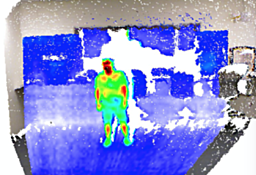Method for Non-Intrusive Determination of Human Comfort Using Low-Cost Thermographic Cameras
TECHNOLOGY NUMBER: 2018-241

OVERVIEW
Low-cost thermographic cameras that determine human comfort- Measures skin temperatures collected from different facial regions
- A non-intrusive method that is scalable in multiple-occupancy situations
BACKGROUND
A person's thermal comfort influences their health and well-being. Thermal comfort refers to the state of satisfaction with the thermal environment, where an individual feels neither too hot nor too cold. It's a subjective perception influenced by various factors including air temperature, humidity, air velocity, clothing insulation, metabolic rate, and personal preferences. Achieving thermal comfort is crucial for maintaining well-being, productivity, and overall satisfaction in indoor environments, whether it's in homes, offices, or other spaces.Thermal discomfort can have several adverse effects such as decrease productivity, decrease concentration, and even contribute to a condition known as "sick building syndrome". Understanding a person's thermal sensation and comfort is essential to defining the optimal settings for temperature regulating systems such as HVAC and potentially lead to energy cost savings. Thermal comfort levels can vary over time; this variation presents a significant challenge to dynamic control of an environment for maximal thermal comfort without constant input. Instead, there is a real-time monitoring solution and a means to adjust ambient temperature without human input.
INNOVATION
Researchers at the University of Michigan have developed a framework using infrared (IR) measurements to estimate an individual's thermal comfort level. This approach assesses thermal comfort level by measuring skin temperature collected from different facial regions using low-cost thermal cameras. This capability allows for the ability to detect the presence of occupants, to extract facial regions, to measure skin temperature features, and to interpret thermal comfort conditions with minimal interruption of the building occupants. The device in non-intrusive, independent of human action, scalable in multi-occupancy scenarios, and allows for continuous physiological data collection. Ultimately, this methodology can interface with smart solutions for dynamic temperature control and increase thermal comfort of occupants.